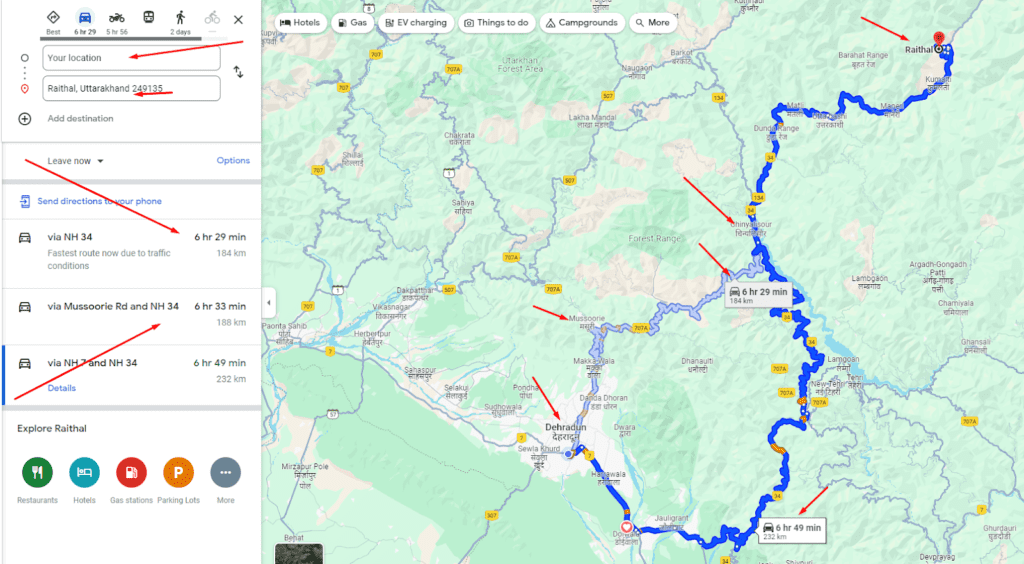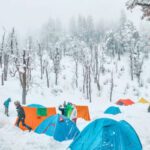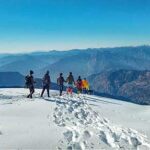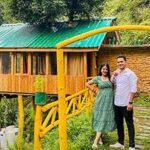
Are you fond of trekking in extreme temperatures? Or Do you want to witness the white wonderland? Or Are you an adventurer who wants to test his strength to bear harsh winter temperatures?
If you answer yes to any of these questions, Dayara Bugyal Trek in winter is your destination.
This winter trek has everything an adventurer or nature lover seeks in a trek. It is full of snow during winter months, has magnificent views of the Himalayas, hosts one of India’s most extensive meadows, and has an enchanting trail to test your endurance.
Don’t believe it? Keep reading further.
I got the opportunity to explore this hidden gem in January month and was stunned to see the amount of beauty Dayara Bugyal trek offers. It is undoubtedly a winter wonderland during winters.
Do you also want to experience this wonderland? Continue reading as I take you on a thrilling journey to the Dayara Bugyal.
I did Dayara Bugyal Trek in the last week of Jan 2023 along with my three friends. As our team was experinced we followed the following itinerary.
- Day 1: A Thrilling Road Journey From Dehradun To Raithal( Uttarkashi)
- Day 2: A Short Trek From Raithal To Gui Campsite
- Day 3: Thrilling Climb To Dayara Bugyal
- Is Dayara Bugyal A Tough Trek?
- How High Is Dayara Bugyal?
- What Is The Best Time To Visit Dayara Bugyal?
- How Much Does The Dayara Bugyal Trek Cost?
Day 1: A Thrilling Road Journey From Dehradun To Raithal( Uttarkashi)
Our journey started in Dehradun.
My three friends and I left Dehradun early in the morning, around 6 am, to reach Raithal on time. Moreover, we were unaware of this place and wanted to avoid being stuck in between.
From Dehradun, there are two routes to Uttarkashi.


- The first route follows NH34, which passes through Mussoorie and Moriyana Top. It is 141 km long.
- The second route follows NH7 and NH 34 and passes via Chamba. This route is around 191 km long and takes longer than the first.
We took the second route, which was more suitable from my home and had wide roads.
The road journey was thrilling, with spectacular mountain views and passing through the famous Chamba Tunnel. You can witness these scenic views in the video below.
After a scenic five-hour journey, as we approached near Uttarakashi, the views were getting prettier, and we could even spot the Himalayas in sprinkling white colour. Continuing our journey with such views, we reached Uttarkashi, a huge town. You will be amazed to see such a massive town at this altitude. It’s a bustling town and falls on the route to Gangotri, one of the holy Char Dham.
At Uttarkashi, we decided to explore the Nehru Institute Of Mountaineering, one of the top mountaineering institutes in India.
Visiting NIM reminded me of my mountaineering course days. NIM has a vast campus and is renowned worldwide for its quality training and numerous mountaineers have trained in this institute.
After exploring NIM, we had lunch at Uttarkashi and left for Raithal with our host. After 15 minutes of drive from Uttarkashi market, we came across a huge waterfall and a mesmerizing lake. It was sheer beauty. You can guess the feeling from the beautiful pictures below.


Moving further towards Raithal village, we were stunned by the beauty of the massive Himalayan range and sourounding farming land. It truly gave us the feeling of being in Heaven. In addition, the views were so massive that you couldn’t take your eyes off them.
On reaching the guest house, we checked in and enjoyed a hot tea with a view of the Himalayas. It was so rejuvenating that we kept discussing it.


Soon, it was getting dark, and the weather was changing as if it would snow. Witnessing the change in weather, we all were excited about snowfall during our Dayara Bugyal Trek.
We closed the day with a delicious Gharwali dinner with bonfire.
Day 2: A Short Trek From Raithal To Gui Campsite
We woke up around 6 am on day two with windy weather outside. It was so chilled that we had to cover our whole body in multiple layers. Although it was windy, the view was worth it.
As the sun rose, the Himalayan peaks glittered in golden colour. We enjoyed our morning tea, witnessing this magical sunrise.
After breakfast, we planned to explore the village before leaving for a trek around 9 am.
The village is like other traditional Pahadi villages, but you will find numerous homestay and trekkers strolling the village.
Chit-chating with locals, we reached the famous place (Kothi), built 500 years ago. It’s a three-story building, which you don’t usually see in the hills and is constructed entirely of wood and mud. The most unique thing about this building is that it can resist earthquakes and has stood there for so long.


Although the building is not in condition to live, you can get inside it to explore how people used to live 500 years ago. Upon entering the building, you will find small doors, wooden stairs, dark rooms, and various storage spaces. You will be surprised to see how every bit of space was utilized inside the building.
After touring the building, we visited the temple, took God’s blessings, and returned to the guest house. We started trekking around 9 am.
Please remember that before starting the Dayar Bugyal trek, you must pay the trek fee per trekker to the forest department. The price is around Rs.100, which keeps on changing. For us, our guide has already paid this previous day.
We took a clearly defined trail from the village with an entry gate that welcomes you to the Dayara Bugyal trek.


Initially, the trail passes through village houses, homestays and farms on both of your sides. Continuing the same route, you climb upwards, leaving the village behind. After 15 minutes of the climb, you reach a beautiful open meadow. Here, you notice many oak trees and a view of great Himalayan peaks glittering in snow. It’s a sight to behold.


Continuing trekking on the trail further takes you inside the dense oak forest with a zig zack trail. You will hardly get sunlight in the woods but encounter many wildlife, including beaitiful birds. In addition, you will also start seeing patches of snow.
We continued on this trail for around 1.5 hours. On passing this section, the forest opens, and you can notice the Gui Campsite from below, with snow all around. As you climb up, the view opens more, and you start noticing camps. Seeing camps while walking on the snow increases your excitement ten times.
We enjoyed hiking on the snow trail and reached GUI campsite after 3 hours of trek. As soon as we entered the open meadow of GUI, we all were stunned to see the views of the Himalayas from the campsite. It was a magnificent experience. We could now see the massive Himalayas in front of us.
You can see in the below picture how massive the views are. In addition to views, the camps with catchy colours were also luring.


While enjoying the views, we pitched our tent on a beautiful spot and ate lunch. After lunch, we visited the GUI lake, which was completely frozen. It was the first time we all had witnessed a frozen lake. Although the lake is small, you can surely enjoy sliding on it during the winter.
In the evening, we collected some wood from the nearby areas for the bonfire. We lit the bonfire and enjoyed dinner with other trekkers as it got dark.
Watch our whole experince of day 2 in this video below.
Day 3: Thrilling Climb To Dayara Bugyal
After struggling to sleep the whole night due to the freezing temperature, I woke up at 4 am to ensure we reach Dayara before sunrise. Our entire team, including the guide, got ready in 30 min, and we left for the summit in the dark.
Motivating each other, we climbed on a snowy, dark trail. Due to it being dark, we couldn’t see anything, but it was a thrilling climb. Continuing on this trail for 2 hours, we passed the Chilapada and reached a spot with four huts. It was an open area with the Himalayas on three sides and Dayara Bugyal on the other side. Our guide told us to wait there till the sun rises.


The landscape around us was fueled with brightness and energy as the sun emerged from behind the peaks. Witnessing this sunrise was a touching experience. It was one of the most beautiful sunrises I have ever witnessed. We all enjoyed this moment with sheer pleasure.
Enjoying the view, we moved on further towards the Dayara Bugyal. As we kept moving further, the view of the Himalayas got bigger and bigger, and even the landscape. Soon we reached Dayara Bugyal. The whole bugyal looked stunning in the knee-deep snow.


We enjoyed playing in the snow, clicking pictures, while cherishing the views of the mighty Himalayas. For my team members, it was the first time they had seen such amount of snow and the stunning veiws of the Himalayas.
After enjoying the Dayara Bugyal, we returned to the same trail and left for the GUI campsite.
We reached GUI by 10 am. As we were on time and nothing more was left to do, I decided to descend to Raithal. Our team reached Raithal after another hour of trek, and then we left for Dehradun.
So, this was my thrilling experience at Dayara Bugyal, which you can also watch in the below video.
By now, you must have been motivated to do Dayara Bugyal Trek in winter. However, still, have many questions in your mind? Don’t worry! In the section below, I will answer those.
Is Dayara Bugyal A Tough Trek?
The toughness of the trek entirely depends on your fitness and experience. I will explain this concept with our example.
If you research the itinerary of Dayara Bugyal Trek on the web, you come across itineraries of 5 to 6 Days, including travel days. However, you must have noticed above that we did the trek in three days. How was it possible?


Again, it was our fitness and my trekking experience. All the people in my team were physically fit, which helped us cover the distance easily and quickly adapt to the altitude and weather. In addition, because of my years of experience, I could make decisions that an inexperienced person couldn’t.
On the other hand, many other teams were also trekking while we were trekking, but they were following the 6-day itinerary. It was as per their fitness and experience.
Apart from fitness and experience, if we consider all other factors, such as trail distance, altitude, weather and landscape, Dyara Bugyal is generally considered an easy-grade trek. It’s so because
- The distance between the campsite is short, which you can easily cover within 2-3 hours of trekking.
- The variation in altitude is also a little. The highest altitude is 12000 Ft.
- Most Of the trek is under forest, which makes it easy for trekkers to acclimatize to the altitude due to the more significant amount of oxygen available.
So, even if you are a beginner, you can easily do this trek by focusing on your fitness. If you are fit, then no trek is challenging for you.
How High Is Dayara Bugyal?
The highest point of the Dayara Bugyal is Dayara Top, at a height of 11,830 ft. Considering this altitude, it’s an easy trek for everyone. Even the altitude gain from one campsite to another is below 2000 ft, which is a perefect for acclimatizing to altitude.
What Is The Best Time To Visit Dayara Bugyal?
Dayara Bugyal is a trek you can do in all seasons except monsoon. And every season offers you different views.
In the winter months, you witness the snow everywhere, while in summer and post-monsoon, you will witness greenery everywhere. And in the autumn season, you witness changing yellow colours.
So, in my opinion, every season is the best time to visit Dayara Bugyal. Also, it depends on you and what you want to see on the trek.


If you want to enjoy the snow, then the winter months, December, January and February, are the best time. If you wish to witness lush green meadows with greenery, August and September are the best months to visit Dayara Bugyal Trek.
How Much Does The Dayara Bugyal Trek Cost?
The Dayara Bugyal Trek’s cost depends on how you choose to trek.
- Trekking with renowned companies costs you between Rs.9500 and Rs. 11500 per person. It includes transport as well.
- Choosing to trek with new companies costs you between Rs. 5000 to Rs.9000 per head.
- Trekking on your own costs you less, around Rs. 4500 per head. But this includes your transport, a group of at least 4 people, a guide and equipment on rent.
All these trek costs are approximate values and keep changing. So, consider them just to get an idea and for budgeting.
Tip: Although trekking with new companies or yourself costs you less, it has many cons.
Trekking with the new company means they have less experience, might compromise on equipment quality and lack efficient rescue strategies. It may ruin your experience. Even doing the trek yourself requires you to arrange and do everything on the trek yourself, from cooking to washing utensils to pitching and packing tents.
Therefore, I always suggest that only if you are an experienced trekker, trek your own or try new companies. But if you want superb service quality and enjoy trekking, always opt for renowned trekking agencies. Although they cost you a little more, they provide a good experience as they have quality equipment and experienced teams.
In The End
From my experience, I can assure you that Dayara Bugyal is the perfect trek for winter. It offers enchanting views of the Himalayas, the sheer pleasure of trekking in snow, and thrilling climbs inside the forest and Dayara meadows. In addition, it is easy to trek due to short distance between the campsite and low altitude.
So, whether you are a beginner or experienced, Dayara Bugyal Trek is definitely for you.
I have answered all your queries related to Dayara Bugyal in this blog. Still, if you have any other questions, comment below or mail me. Also, if you have anything to share about the Dayara Bugyal trek, you can do so in the comments.







